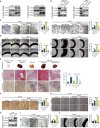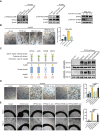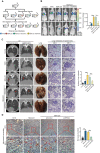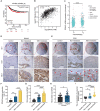Exosomal EPHA2 derived from highly metastatic breast cancer cells promotes angiogenesis by activating the AMPK signaling pathway through Ephrin A1-EPHA2 forward signaling
- PMID: 35673569
- PMCID: PMC9169374
- DOI: 10.7150/thno.72404
Exosomal EPHA2 derived from highly metastatic breast cancer cells promotes angiogenesis by activating the AMPK signaling pathway through Ephrin A1-EPHA2 forward signaling
Abstract
Rationale: Angiogenesis is a fundamental process of tumorigenesis, growth, invasion and metastatic spread. Extracellular vesicles, especially exosomes, released by primary tumors promote angiogenesis and cancer progression. However, the mechanism underlying the pro-angiogenic potency of cancer cell-derived exosomes remains poorly understood. Methods: Exosomes were isolated from breast cancer cells with high metastatic potential (HM) and low metastatic potential (LM). The pro-angiogenic effects of these exosomes were evaluated by in vitro tube formation assays, wound healing assays, rat arterial ring budding assays and in vivo Matrigel plug assays. Subsequently, RNA sequencing, shRNA-mediated gene knockdown, overexpression of different EPHA2 mutants, and small-molecule inhibitors were used to analyze the angiogenesis-promoting effect of exosomal EPHA2 and its potential downstream mechanism. Finally, xenograft tumor models were established using tumor cells expressing different levels of EPHA2 to mimic the secretion of exosomes by tumor cells in vivo, and the metastasis of cancer cells were monitored using the IVIS Spectrum imaging system and Computed Tomography. Results: Herein, we demonstrated that exosomes produced by HM breast cancer cells can promote angiogenesis and metastasis. EPHA2 was rich in HM-derived exosomes and conferred the pro-angiogenic effect. Exosomal EPHA2 can be transferred from HM breast cancer cells to endothelial cells. Moreover, it can stimulate the migration and tube-forming abilities of endothelial cells in vitro and promote angiogenesis and tumor metastasis in vivo. Mechanistically, exosomal EPHA2 activates the AMPK signaling via the ligand Ephrin A1-dependent canonical forward signaling pathway. Moreover, inhibition of the AMPK signaling impairs exosomal EPHA2-mediated pro-angiogenic effects. Conclusion: Our findings identify a novel mechanism of exosomal EPHA2-mediated intercellular communication from breast cancer cells to endothelial cells in the tumor microenvironment to provoke angiogenesis and metastasis. Targeting the exosomal EPHA2-AMPK signaling may serve as a potential strategy for breast cancer therapy.
Keywords: EPHA2; angiogenesis; breast cancer; exosomes; high metastatic potential cells.
© The author(s).
Conflict of interest statement
Competing Interests: The authors have declared that no competing interest exists.
Figures








Similar articles
-
Drug-resistant cancer cell-derived exosomal EphA2 promotes breast cancer metastasis via the EphA2-Ephrin A1 reverse signaling.Cell Death Dis. 2021 Apr 20;12(5):414. doi: 10.1038/s41419-021-03692-x. Cell Death Dis. 2021. PMID: 33879771 Free PMC article.
-
The Ephrin-A1/EPHA2 Signaling Axis Regulates Glutamine Metabolism in HER2-Positive Breast Cancer.Cancer Res. 2016 Apr 1;76(7):1825-36. doi: 10.1158/0008-5472.CAN-15-0847. Epub 2016 Feb 1. Cancer Res. 2016. PMID: 26833123 Free PMC article.
-
MicroRNA-100 shuttled by mesenchymal stem cell-derived exosomes suppresses in vitro angiogenesis through modulating the mTOR/HIF-1α/VEGF signaling axis in breast cancer cells.Cell Oncol (Dordr). 2017 Oct;40(5):457-470. doi: 10.1007/s13402-017-0335-7. Epub 2017 Jul 24. Cell Oncol (Dordr). 2017. PMID: 28741069
-
Roles of EphA1/A2 and ephrin-A1 in cancer.Cancer Sci. 2019 Mar;110(3):841-848. doi: 10.1111/cas.13942. Epub 2019 Feb 15. Cancer Sci. 2019. PMID: 30657619 Free PMC article. Review.
-
The EphA2 receptor and ephrinA1 ligand in solid tumors: function and therapeutic targeting.Mol Cancer Res. 2008 Dec;6(12):1795-806. doi: 10.1158/1541-7786.MCR-08-0244. Mol Cancer Res. 2008. PMID: 19074825 Free PMC article. Review.
Cited by
-
EphA2 as a phase separation protein associated with ferroptosis and immune cell infiltration in colorectal cancer.Aging (Albany NY). 2023 Nov 16;15(22):12952-12965. doi: 10.18632/aging.205212. Epub 2023 Nov 16. Aging (Albany NY). 2023. PMID: 37980165 Free PMC article.
-
Exosomes: new targets for understanding axon guidance in the developing central nervous system.Front Cell Dev Biol. 2025 Jan 9;12:1510862. doi: 10.3389/fcell.2024.1510862. eCollection 2024. Front Cell Dev Biol. 2025. PMID: 39850798 Free PMC article. Review.
-
Eph receptors and ephrins in cancer progression.Nat Rev Cancer. 2024 Jan;24(1):5-27. doi: 10.1038/s41568-023-00634-x. Epub 2023 Nov 23. Nat Rev Cancer. 2024. PMID: 37996538 Free PMC article. Review.
-
The role and application of vesicles in triple-negative breast cancer: Opportunities and challenges.Mol Ther Oncolytics. 2023 Nov 23;31:100752. doi: 10.1016/j.omto.2023.100752. eCollection 2023 Dec 19. Mol Ther Oncolytics. 2023. PMID: 38130701 Free PMC article. Review.
-
Blockade of Exosome Release Sensitizes Breast Cancer to Doxorubicin via Inhibiting Angiogenesis.Cancer Med. 2025 Apr;14(8):e70785. doi: 10.1002/cam4.70785. Cancer Med. 2025. PMID: 40249328 Free PMC article.
References
-
- Sung H, Ferlay J, Siegel RL, Laversanne M, Soerjomataram I, Jemal A. et al. Global Cancer Statistics 2020: GLOBOCAN Estimates of Incidence and Mortality Worldwide for 36 Cancers in 185 Countries. CA Cancer J Clin. 2021;71:209–49. - PubMed
-
- Arnedos M, Vicier C, Loi S, Lefebvre C, Michiels S, Bonnefoi H. et al. Precision medicine for metastatic breast cancer-limitations and solutions. Nat Rev Clin Oncol. 2015;12:693–704. - PubMed
-
- Liu MC, Cortés J, O'Shaughnessy J. Challenges in the treatment of hormone receptor-positive, HER2-negative metastatic breast cancer with brain metastases. Cancer Metastasis Rev. 2016;35:323–32. - PubMed
Publication types
MeSH terms
Substances
LinkOut - more resources
Full Text Sources
Medical
Research Materials
Miscellaneous

